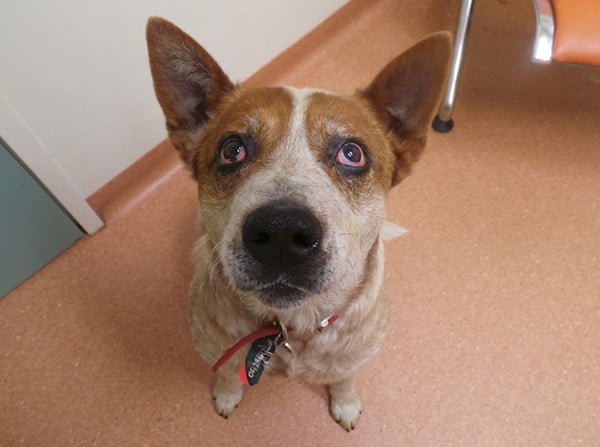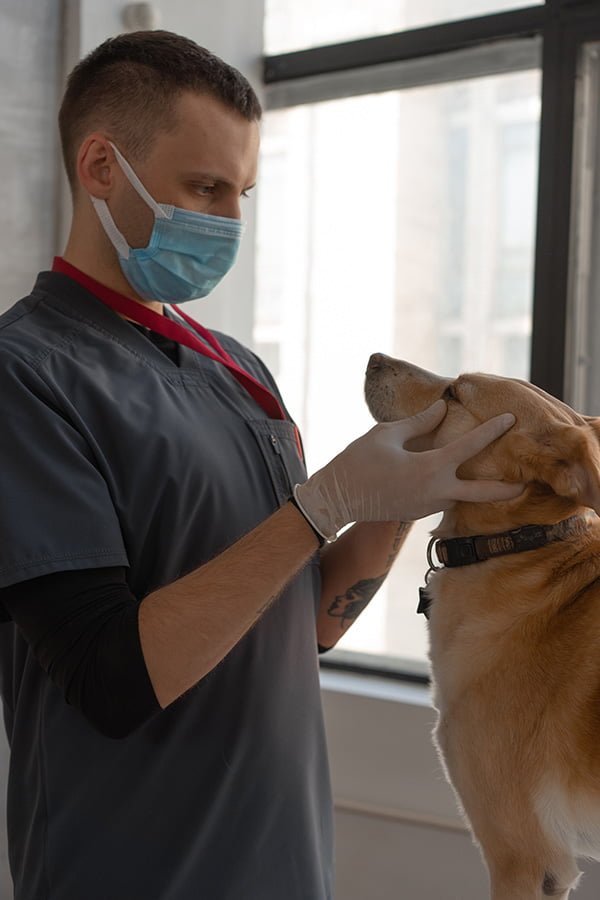Eyes may be the window to our fur babies' souls, and keeping them healthy is vital for maintaining their comfort and interactions with their environment. There are many conditions that can affect your dog’s eyes, ranging from mild and easily treatable to severe. One of the most common conditions is conjunctivitis, which can cause a red, swollen eye. Whatever the underlying cause, eye issues in dogs can be painful and progress quickly. As a pet parent, it is important to watch for signs of a problem and see your veterinarian as soon as possible if you have any concerns about your dog's eyes.
What is Conjunctivitis in Dogs?
Conjunctivitis is a broad term referring to inflammation of the conjunctiva, the mucous membrane that covers your dog's eyeball and the inner part of the eyelids. Dogs also have a third eyelid (nictitating membrane) that is covered by conjunctiva and not normally visible.
Inflammation leads to red, warm, swollen, and painful tissue. There are many possible underlying causes of conjunctivitis, some of which are associated with infection or injury to the eye, or it may be a symptom of a more serious or systemic underlying disease. Conjunctivitis may also be referred to as dog pink eye.
Symptoms of Conjunctivitis
In normal dogs, the conjunctiva is pale pink and not easily visible, and the third eyelid is retracted. Symptoms of conjunctivitis may involve one or both eyes, and vary based on the underlying cause, but often include:
Redness and swelling of the tissue around the eyeball
Ocular (eye) discharge - may be clear, cloudy, yellow, or green
Squinting or blinking
Pawing or rubbing at face
It may or may not be associated with nasal discharge, sneezing, coughing, or other signs of illness

Source: Flickr
How Do Dogs Get Pink Eyes?
Canine conjunctivitis refers to inflammation, and may be due to many possible underlying causes. A veterinary exam and diagnostic testing will be needed to determine the underlying cause and best treatment options for your dog.
Infection - Infection (viral, bacterial, or parasitic) is a possible cause of conjunctivitis in dogs. The infection may be localized to the eye or be systemic (affecting the whole body, such as canine distemper or herpesvirus). Regardless of the underlying cause of conjunctivitis, the eye will frequently become secondarily infected by bacteria.
Environmental irritants or allergies - Allergies in dogs commonly cause pruritus (itchy skin) and predispose dogs to skin and ear infections. However, some dogs can also present with allergic conjunctivitis, causing red and watery eyes.
Foreign bodies in the eye
Corneal injury, trauma, or ulcer
Anatomical abnormality - Some breeds of dogs are predisposed to eyelid abnormalities (entropion or ectropion), cherry eye, blocked tear ducts, eyelash abnormalities , etc.
Immune-mediated - Including conditions such as plasma-cell conjunctivitis or pemphigus.
Breed-related - Some breeds are predisposed to other conditions, such as nodular episcleritis in collies.
Keratoconjunctivitis Sicca - This condition, known as dry eye, occurs when there is insufficient tear production.
Mass or tumor
Other eye disorders - Other ocular disorders such as glaucoma, anterior uveitis, or ulcerative keratitis, can also cause a red, irritated eye.
It can also be helpful to distinguish between causes of unilateral (affecting only one eye) and bilateral (affecting both eyes) conjunctivitis. For example, a viral infection or allergy is likely to cause conjunctivitis in both eyes, while a foreign body or tumor may only affect one.
How is Conjunctivitis Diagnosed?
When you see your vet for a concern about your dog's eye, they will start by getting a history and performing a thorough physical exam. There are three common tests that your vet may recommend to gather additional information about the cause of your dog’s conjunctivitis and help guide their treatment recommendations.
Fluorescein stain - This test checks for the presence of a corneal injury or ulcer. A small amount of stain is applied to the eye, which will stick to areas of ulceration and glow under black light.
Schmear tear test - This test is used to measure tear production. It involves placing the tip of a special filter paper inside the lower eyelid and waiting for 60 seconds.
Tonometry - This test involves gently touching the surface of the eye with a Tonopen to measure pressures within the eye. Intraocular pressure may be elevated in glaucoma or decreased in uveitis.
Additionally, your vet may perform a fundic exam to evaluate the back of your dog’s eye. In some cases, they may also recommend referral to an ophthalmologist.
What is the Treatment for Dog Conjunctivitis?
The dog conjunctivitis treatment will focus on treating the underlying cause and alleviating symptoms. Often a topical ophthalmic antibiotic with or without a steroid is all that’s needed. Steroids are excellent at decreasing inflammation. However, it is important to perform a fluorescein stain prior to dispensing this medication as it can delay healing if an ulcer is present.
In some cases oral medications may be needed. Surgery may be indicated if a mass or eyelid abnormality contributes to the conditioning. A dry eye cannot be cured, but can generally be well managed with lifelong topical ophthalmic medications.
Whatever the underlying cause, an E-collar is also often needed short-term to help prevent additional damage due to pawing or rubbing at the eyes from discomfort.
Recovery From Conjunctivitis
Most simple cases of conjunctivitis should fully resolve within a couple of weeks of using a topical treatment. It is important to monitor your dog’s symptoms carefully and contact your vet if they are not improving or are getting worse. Improvement should be noted within a few days of starting treatment.
As conjunctivitis can sometimes be a sign of more serious systemic disease or other underlying issues, it is important to follow up and discuss any concerns with your vet. If an animal does not respond to initial treatment or if conjunctivitis recurs, it may be a clue that additional investigation is needed. Certain conditions, such as dry eye, will require lifelong treatments, however can be well controlled with medication.
Can Conjunctivitis Be Prevented?
In most cases conjunctivitis cannot be prevented. However, making sure your dog is up to date on vaccines and parasite prevention is a great start to keeping them healthy. If your dog has an allergy, avoiding environmental irritants and gently cleaning their eyes may also be beneficial.

Source: Pexels
FAQ
Do I need to take my dog to the vet for conjunctivitis?
Yes, it is important to have your dog evaluated by a vet as soon as possible for any issue involving their eyes. Conjunctivitis is common and easily treatable in many cases however, it usually requires a prescription medication from your vet. In some cases it can be an indicator of more significant systemic disease.
How do you treat conjunctivitis at home?
Your dog must see a vet to diagnose and treat conjunctivitis appropriately. If an over-the-counter treatment is indicated (such as saline or lubricating eye drops, or an antihistamine to help manage allergies), then your vet will discuss how and when to use it.
How do you give eye drops to a dog?
Applying medication to a wiggly dog’s eye can be difficult and intimidating. On top of that, many eye medications must be applied several times per day. Some ophthalmic medications come in either drops or ointment, and you may find that one form is easier than the other.
Your veterinary team can give you a demonstration in the clinic, and many great videos are available online as well. In general, it is best to hold your dog closely against your body and come from behind to apply the drops. Never let the bottle touch their eye. Be sure to pair the experience with lots of positive reinforcement like treats and praise.
Is conjunctivitis contagious and can it be spread to humans?
If there is a viral or bacterial infection causing conjunctivitis in your dog, it is possible that it could spread to other dogs. In very rare cases bacterial conjunctivitis may also be passed to a human caretaker. This can easily be avoided by washing your hands after handling your dog’s face and eyes, and contacting your doctor with any questions or concerns about your own health. If your dog frequents doggy daycare or the dog park, it may be best to keep them home while recovering, as well as separate from other dogs in the household.
Will dog conjunctivitis go away by itself?
Conjunctivitis will not go away on its own and requires medical management by a vet. If left untreated it could lead to permanent damage to your dog’s eyes or vision. Most cases will resolve quickly and easily with appropriate treatment.
How long does conjunctivitis in dogs last?
Most simple cases of conjunctivitis should fully resolve within two to three weeks of appropriate care and treatment. Improvement should be noted within the first few days after starting treatment. Depending on the underlying cause, the condition may recur and/or require additional diagnostics and treatments.
